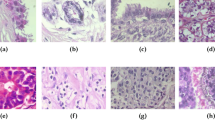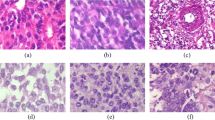Abstract
Breast cancer is a serious and high morbidity disease in women, and it is the main cause of cancer death in China. However, getting tested and diagnosed early can reduce the risk of cancer. At present, there are clinical examinations, imaging screening and biopsies, among which histopathological examination is the gold standard. However, the process is complicated and time-consuming, and misdiagnosis may exist. This paper puts forward a classification framework based on deep learning, introducing multi-attention mechanism, selecting kernel convolution instead of ordinary convolution, and using different weights and combinations to pay attention to the accuracy index and growth rate of the model. In addition, we also compared the learning rate regulators. Error function can fine-tune the learning rate to achieve good performance, using label softening to reduce the loss error caused by model error recognition in the label, and assigning different category weights in the loss function to balance the positive and negative samples. We used the BreakHis data set to automatically classify histological images into benign and malignant, four categories and eight subtypes. Experimental results showed that the accuracy of binary classifications ranged from 98.23% to 98.83%, and that of multiple classifications ranged from 97.89% to 98.11%.
摘要
乳腺癌是在女性中致病严重并且发病率较高的疾病, 是全国女性癌症死亡的主要原因。然而, 提前进行检查和诊断可以减少癌症的风险。现在, 对于乳腺癌的诊断方法有临床检查、影像学筛查和活组织检查, 其中组织病理学检查是金标准。但整个过程比较复杂和耗时, 可能还会存在误诊情况。本文提出利用深度学**衡**负样本不**衡问题。我们采用BreakHis数据集自动分类乳腺癌组织学图像为良性和恶性、四分类以及八个亚型。实验结果表明, 二分类准确率为98.23%∼98.83%, 多分类准确率在97.89%与98.11%之间。
Similar content being viewed by others
References
Global Burden of Disease Cancer Collaboration, FITZMAURICE C, AKINYEMIJU T F, et al. Global, regional, and national cancer incidence, mortality, years of life lost, years lived with disability, and disability-adjusted life-years for 29 cancer groups, 1990 to 2016: A systematic analysis for the global burden of disease study [J]. JAMA Oncology, 2018, 4(11): 1553–1568.
ZHANG Y J, WEI L C, LI J, et al. Status quo and development trend of breast biopsy technology [J]. Gland Surgery, 2013, 2(1): 15–24.
HADJIISKI L, SAHINER B, CHAN H P. Advances in computer-aided diagnosis for breast cancer [J]. Current Opinion in Obstetrics & Gynecology, 2006, 18(1): 64–70.
KAUSHAL C, BHAT S, KOUNDAL D, et al. Recent trends in computer assisted diagnosis (CAD) system for breast cancer diagnosis using histopathological images [J]. IRBM, 2019, 40(4): 211–227.
SHEN D G, WU G R, SUK H I. Deep learning in medical image analysis [J]. Annual Review of Biomedical Engineering, 2017, 19: 221–248.
WANG P, HU X L, LI Y M, et al. Automatic cell nuclei segmentation and classification of breast cancer histopathology images [J]. Signal Processing, 2016, 122(1): 1–13.
XIE J Y, LUTTRELL J IV, ZHANG C Y, et al. Deep learning based analysis of histopathological images of breast cancer [J]. Frontiers in Genetics, 2019, 10: 80.
OSAREH A, SHADGAR B. Machine learning techniques to diagnose breast cancer [C]//2010 5th International Symposium on Health Informatics and Bioinformatics. Ankara: IEEE, 2010: 114–120.
CHENHL, YANGB, LIUJ, et al. Asupport vetor machine classifier with rough set-based feature selection for breast cancer diagnosis [J]. Expert Systems With Applications, 2011, 38(7): 9014–9022.
GUPTA M, GUPTA B. An ensemble model for breast cancer prediction using sequential least squares programming method (SLSQP) [C]//2018 Eleventh International Conference on Contemporary Computing. Noida: IEEE, 2018: 1–3.
KASHIF M, MALIK K R, JABBAR S, et al. Application of machine learning and image processing for detection of breast cancer [M]//Innovation in health informatics. Amsterdam: Elsevier, 2020: 145–162.
SPANHOL F A, OLIVEIRA L S, CAVALIN P R, et al. Deep features for breast cancer histopathological image classification [C]//2017 IEEE International Conference on Systems, Man, and Cybernetics. Banff: IEEE, 2017: 1868–1873.
DAS K, CONJETI S, ROY A G, et al. Multiple instance learning of deep convolutional neuralnetworks for breast histopathology whole slide classification [C]//2018 IEEE 15th International Symposium on Biomedical Imaging. Washington: IEEE, 2018: 578–581.
GUO Y, DONG H H, SONG F Z, et al. Breast cancer histology image classification based on deep neural networks [C]. International conference image analysis and recognition. Povoa de Varzim: Springer, 2018: 827–836.
AKBAR S, PEIKARI M, SALAMA S, et al. The transition module: A method for preventing overfitting in convolutional neural networks [J]. Computer Methods in Biomechanics and Biomedical Engineering: Imaging & Visualization. 2019, 7(3): 260–265.
WEI B Z, HAN Z Y, HE X Y, et al. Deep learning model based breast cancer histopathological image classification [C]//2017 IEEE 2nd International Conference on Cloud Computing and Big Data Analysis. Chengdu: IEEE, 2017: 348–353.
HE K M, ZHANG X Y, REN S Q, et al. Identity map**s in deep residual networks [M]// Computer vision - ECCV 2016. Amsterdam: Springer, 2016: 630–645.
HE K M, ZHANG X Y, REN S Q, et al. Deep residual learning for image recognition [C]//2016 IEEE Conference on Computer Vision and Pattern Recognition. Las Vegas: IEEE, 2016: 770–778.
HU J, SHEN L, ALBANIE S, et al. Squeeze-and-excitation networks [J]. IEEE Transactions on Pattern Analysis and Machine Intelligence, 2020, 42(8): 2011–2023.
LI X, WANG W H, HU X L, et al. Selective kernel networks [C]//2019 IEEE/CVF Conference on Computer Vision and Pattern Recognition. Long Beach: IEEE, 2019: 510–519.
KRIZHEVSKY A, SUTSKEVER I, HINTON G E, et al. ImageNet classification with deep convolutional neural networks [J]. Communications of the ACM, 2017, 60(6): 84–90.
SIMONYAN K, ZISSERMAN A. Very deep convolutional networks for large-scale image recognition [C]//3rd International Conference on Learning Representations. San Diego: Computational and Biological Learning Society, 2015: 1–14.
SZEGEDY C, LIU W, JIA Y Q, et al. Going deeper with convolutions [C]//2015 IEEE Conference on Computer Vision and Pattern Recognition. Boston: IEEE, 2015: 1–9.
WANG F, JIANG M Q, QIAN C, et al. Residual attention network for image classification [C]//2017 IEEE Conference on Computer Vision and Pattern Recognition. Honolulu: IEEE, 2017: 6450–6458.
XU K, BA J L, KIROS R, et al. Show, attend and tell: Neural image caption generation with visual attention [C]//International Conference on Machine Learning. Lille: PMLR, 2015: 2048–2057.
LUCA M, BARLACCHI G, LEPRI B, et al. A survey on deep learning for human mobility [J]. ACM Computing Surveys, 2021, 55(1): 1–44.
LUONG T, PHAM H, MANNING C D. Effective approaches to attention-based neural machine translation [C]//2015 Conference on Empirical Methods in Natural Language Processing. Lisbon: Association for Computational Linguistics, 2015: 1412–1421.
HOU Q B, ZHOU D Q, FENG J S. Coordinate attention for efficient mobile network design [C]//2021 IEEE/CVF Conference on Computer Vision and Pattern Recognition. Nashville: IEEE, 2021: 13708–13717.
WANG Q L, WU B G, ZHU P F, et al. ECA-net: Efficient channel attention for deep convolutional neural networks [C]//2020 IEEE/CVF Conference on Computer Vision and Pattern Recognition. Seattle: IEEE, 2020: 11531–11539.
SIFRE L, MALLAT S. Rigid-motion scattering for texture classification [DB/OL]. (2014-05-07) [2023-05-25]. https://arxiv.org/abs/1403.1687
Müller R, Kornblith S, Hinton G E. When does label smoothing help? [C]//33rd Conference on Neural Information. Vancouver: Curran Associates, 2019: 1–13.
JIANG Y, CHEN L, ZHANG H, et al. Breast cancer histopathological image classification using convolutional neural networks with small SE-ResNet module [J]. PLoS One, 2019, 14(3): e0214587.
LIN T Y, GOYAL P, GIRSHICK R, et al. Focal loss for dense object detection [C]//2017 IEEE International Conference on Computer Vision. Venice: IEEE, 2017: 2999–3007.
BARDOU D, ZHANG K, AHMAD S M. Classification of breast cancer based on histology images using convolutional neural networks [J]. IEEE Access, 2018, 6: 24680–24693.
JIANG Y, CHEN L, ZHANG H, et al. Breast cancer histopathological image classification using convolutional neural networks with small SE-ResNet module [J]. PLoS One, 2019, 14(3): e0214587.
SHEIKH T S, LEE Y, CHO M. Histopathological classification of breast cancer images using a multi-scale input and multi-feature network [J]. Cancers, 2020, 12(8): 2031.
BOUMARAF S, LIU X B, ZHENG Z S, et al. A new transfer learning based approach to magnification dependent and independent classification of breast cancer in histopathological images [J]. Biomedical Signal Processing and Control, 2021, 63: 102192.
HAN Z Y, WEI B Z, ZHENG Y J, et al. Breast cancer multi-classification from histopathological images with structured deep learning model [J]. Scientific Reports, 2017, 7: 4172.
RULANINGTYAS R, HYPERASTUTY A S, RAHAJU A S. Histopathology grading identification of breast cancer based on texture classification using GLCM and neural network method [J]. Journal of Physics: Conference Series, 2018, 1120: 012050.
DIMITROPOULOS K, BARMPOUTIS P, ZIOGA C, et al. Grading of invasive breast carcinoma through grassmannian VLAD encoding [J]. PLoS One, 2017, 12(9): e0185110.
NAHID A A, ALI MEHRABI M, KONG Y N. Histopathological breast cancer image classification by deep neural network techniques guided by local clustering [J]. BioMed Research International, 2018, 2018: 2362108.
LAO Q, FEVENS T. Case-based histopathological malignancy diagnosis using convolutional neural networks [DB/OL]. (2019-05-28) [2023-05-25]. http://arxiv.org/abs/1905.11567
HAMEED Z, ZAHIA S, GARCIA-ZAPIRAIN B, et al. Breast cancer histopathology image classification using an ensemble of deep learning models [J]. Sensors, 2020, 20(16): 4373.
Acknowledgments
This work is an innovative study based on the breast cancer histopathology data set BreakHis provided by P&D Laboratories.
Author information
Authors and Affiliations
Corresponding author
Ethics declarations
Conflict of Interest The authors declare that they have no potential conflict of interest.
Additional information
Foundation item: the University Synergy Innovation Program of Anhui Province (No. GXXT-2022-041)
Rights and permissions
About this article
Cite this article
Xu, W., Xu, L., Liu, N. et al. Histological Image Diagnosis of Breast Cancer Based on Multi-Attention Convolution Neural Network. J. Shanghai Jiaotong Univ. (Sci.) (2024). https://doi.org/10.1007/s12204-024-2705-4
Received:
Accepted:
Published:
DOI: https://doi.org/10.1007/s12204-024-2705-4




